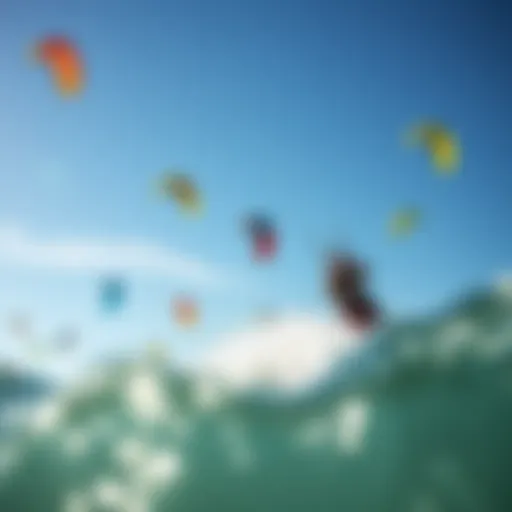Kiteboarding Kites for Sale: A Comprehensive Guide
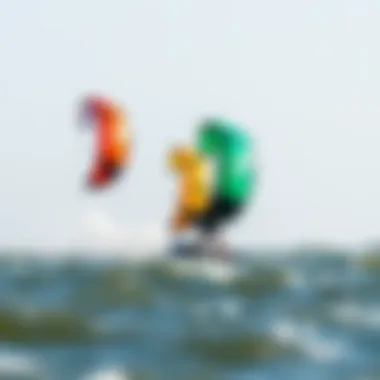
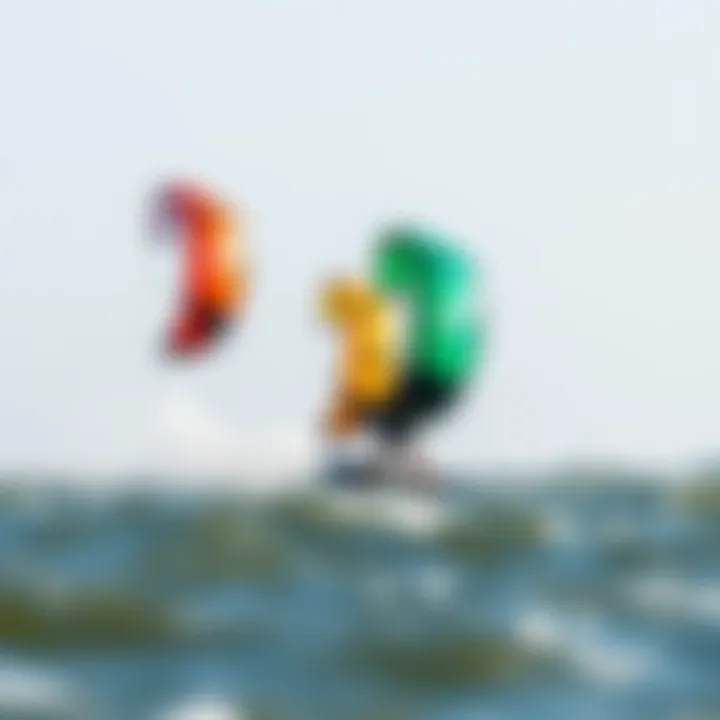
Intro
Kiteboarding has evolved into a thrilling water sport, drawing a diverse crowd of adrenaline junkies and seaside lovers alike. At its core, kiteboarding combines elements of surfing, windsurfing, and paragliding, allowing riders to harness the wind with a specially designed kite. However, selecting the right kite can be a daunting task, especially for beginners. When navigating the myriad of options available today, understanding the techniques and equipment is crucial for maximizing enjoyment and performance on the water.
With this guide, enthusiasts from all walks of life can explore an extensive range of kiteboarding kites for sale, delve into techniques for managing them effectively, and become acquainted with equipment reviews that highlight quality brands. This resource is designed to empower every kiteboarder—from novices to experienced riders—with the knowledge they need to make informed choices, ensuring every ride is smooth and exhilarating. Let's dive deeper to discover essential kiteboarding techniques for enthusiasts, followed by equipment reviews that will enlighten your shopping journey.
Techniques for Kiteboarding Enthusiasts
Mastering kiteboarding isn't solely about selecting the best equipment; it's about honing your skills and understanding the wind, water, and kite dynamics. Here’s a look at the foundational techniques that all kiteboarders should grasp before hitting the waves.
Beginner Techniques
If you're just starting, your primary focus should be on understanding the basics, particularly how to control the kite and maintain balance on the board. Here are key steps to get you started:
- Kite Setup: Always check your lines and make sure your kite is correctly set up. This will save you a considerable headache later.
- Wind Window: Familiarize yourself with the wind window concept. It’s where your kite flies; understanding its limits is fundamental.
- Body Dragging: This technique helps you learn how to control the kite while in the water without the board. It builds confidence and enhances your kite control.
- Water Start: Moving from body dragging to water starting requires practice. Position the board at your feet and use the power of the kite to lift you onto the board while staying balanced.
Advanced Maneuvers
Once you’ve gained confidence on your board, advancing to more complex moves will elevate your kiteboarding experience. Here are some essential tricks and maneuvers:
- Jumping: This is a real crowd-pleaser. To get started, you need to build speed and use the kite's power at the right moment to launch into the air.
- Unhooked Tricks: For more advanced riders, unhooked tricks become a natural progression. It involves releasing your harness from the kite and performing spins and grabs.
- Downloops: A downloop is an exciting maneuver that requires precision and timing. While descending from a jump, you turn the kite in the opposite direction to generate additional lift.
"Kiteboarding isn't just about the kite; it's the connection between rider and wind that creates magic on the water."
Equipment Reviews
Understanding the type of kites and boards available is essential for choosing the right gear. After all, having the right equipment can make or break your experience on the water.
Kite Reviews
Selecting a kite involves more than just brand loyalty; it’s about understanding the kite's characteristics, including shape, size, and purpose. Here are a few noteworthy kites discussing various skill levels:
- North Reach: This is a versatile all-around kite suited for various conditions. It offers stability and is great for both cruising and advanced maneuvers.
- F-One Bandit: Recognized for its performance, this kite delivers exceptional boost for jumps and stable handling in gusty winds.
- Cabrinha Switchblade: A popular choice amongst many, it provides a smooth ride and is particularly forgiving for beginners.
Board Reviews
The right board is equally crucial as it complements your kite. Here's a selection of boards that stand out in the market:
- Slingshot Misfit: Perfect for beginner to intermediate riders, this board offers great stability and comfort.
- Blade Spark: Tailored for serious performance, it excels in speed and responsiveness, ideal for advanced maneuvers.
- Naish Monarch: A high-performance board that contributes to great agility and allows for spectacular air tricks.
Each piece of equipment plays a vital role in the kiteboarding experience. By understanding both kites and boards, riders can create a tailored setup that meets their personal needs and enhances their performance on the water.
Understanding Kiteboarding Kites
When it comes to kiteboarding, the kite is the heart and soul of the experience. Without a solid understanding of the different kites available, enthusiasts might find themselves struggling to harness the wind efficiently—or worse, feeling frustrated on the water. This guide aims to provide a clearer grasp of kiteboarding kites, focusing on their specific functionalities, advantages, and how they suit various riding styles.
The Role of Kites in Kiteboarding
Kites serve not only as a means of propulsion but also play a pivotal role in the overall riding experience. The unique designs allow kiteboarders to traverse water with agility and style. A good kite can help riders to catch more wind, generate lift, and maneuver smoothly across the waves, elevating their performance. Therefore, selecting the right kite is not just a matter of preference; it's essential for enhancing control and enjoyment during sessions.
Types of Kiteboarding Kites
Kiteboarding kites come in several shapes and styles, each catering to different conditions and rider preferences. Being aware of the various types can significantly influence a rider's experience out on the water.
Foil Kites
Foil kites are unique in their design, featuring an inflatable structure that creates an airfoil shape when in use. This type is known for its lightweight construction and the ability to generate lift efficiently. As such, many riders find foil kites to be a popular choice for light wind conditions, offering an impressive ability to stay aloft with minimal wind.
One key characteristic of foil kites is their stability in the air, making them particularly advantageous for beginners looking to learn the ropes without excessive pull. However, they can be less effective in strong winds compared to tube kites due to their susceptibility to collapsing in high gusts.
Tube Kites
Tube kites, the most recognized type of kiteboarding kite, are equipped with inflatable tubes, offering a robust structure that can handle a wide range of wind conditions. Their design typically includes a defined leading edge, enhancing aerodynamics and stability. Riders appreciate tube kites because they provide excellent power control and relaunch capabilities. This is crucial for freestyle kiteboarders who desire (and need) to perform tricks and jumps. Moreover, their ability to handle rough waters makes tube kites a favorite among advanced riders. The downside, however, is their requirement for a bit more wind to function optimally compared to their foil counterparts.
Delta Kites
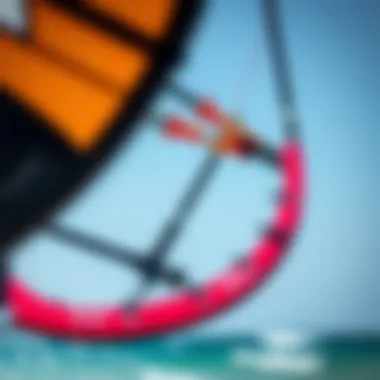
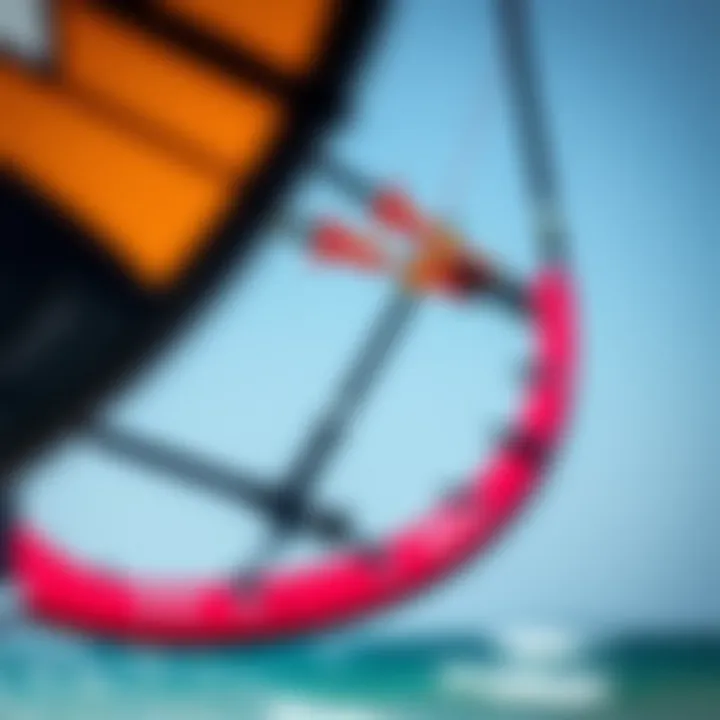
Delta kites are characterized by their triangular shape, which doesn’t just make them look different but also enhances performance attributes. This type is advantageous for all levels, as it provides stable flight and good lift characteristics. The distinctive shape allows for better upwind performance, making delta kites suitable for variable wind conditions. Many find delta kites to be a versatile choice due to their relatively forgiving nature when it comes to high winds. However, they can be less responsive than tube kites, making tricks slightly more challenging.
In summary, understanding the various types of kiteboarding kites, such as foil, tube, and delta kites, can help riders make informed decisions tailored to their individual needs and riding styles. The role these kites play is paramount in shaping the kiteboarding experience, influencing everything from performance to enjoyment. Navigating the nuances of kite selection will ultimately lead to a more fulfilling adventure on the waves.
Key Features of Kiteboarding Kites
When it comes to kiteboarding, choosing the right kite is pivotal. The performance of the kite can significantly impact your ride, whether you're just starting or are an experienced rider. Understanding the key features of kiteboarding kites is critical for making informed decisions and optimizing your experience on the water.
Several key features can make a substantial difference in how well a kite behaves under various wind conditions. Proper knowledge of these features can help you match kites to your personal style and riding conditions. The following sections delve into important aspects including material and durability, size and performance dynamics, and wind range compatibility.
Material and Durability
In kiteboarding, the materials used play a crucial role in how a kite performs and lasts over time. Kites are often made from ripstop nylon or polyester, which are both lightweight and resistant to tearing. This durability is essential because, while riding, kites face a considerable amount of stress and strain.
A quality kite crafted from high-end materials withstands the test of time, which is particularly beneficial for those who frequently go out riding in challenging conditions. Here are a few points to ponder when considering material and durability:
- Weight vs. Strength: A kite should strike a balance between lightweight for ease of use and strong enough to endure windy conditions.
- Seams and Stitching: The way seams are stitched can significantly affect a kite's longevity. Reinforced stitching is a marker of quality.
- Resistance to UV Light: High-quality materials often have better resistance to fading and damage from the sun, which extends the life of your kite.
Navigating the market can be tricky with many options available, so paying attention to the material details can serve you well in the long run.
Size and Performance Dynamics
Kite size is another crucial factor that affects its performance. Generally, kite size influences lift, power, and speed. Larger kites create more power and lift, making them suitable for lighter winds, while smaller kites are better for high-wind conditions where speed and control are more critical.
Determining the right size involves understanding your skill level and the conditions in which you intend to ride. Here's what to take into account:
- Skill Level: Beginners often find larger kites easier to control as they generate more power. However, as skills progress, the advantage of smaller, faster kites becomes clear.
- Wind Conditions: During strong winds, a smaller kite will perform better, enabling quicker response times and improved control.
- Riding Style: Freestyle riders may prefer smaller kites for tricks, while wave riders may lean toward larger kites for stability.
Understanding how size relates to performance will enhance your riding experience, allowing you to select kites that suit your individual needs.
Wind Range Compatibility
One of the most significant considerations when purchasing a kite is its wind range compatibility. Kites are designed to operate within specific wind speeds, so knowing this can help you choose not just based on your riding skill, but also the usual conditions you face.
Kites with a broader wind range offer more versatility, enabling you to ride in varying conditions without having to switch kites constantly. Important points to think about include:
- Low End and High End: Every kite has a low-end (the minimum wind speed necessary for the kite to fly) and a high-end (the maximum wind speed before it becomes uncontrollable). This defines where you can comfortably ride.
- Adaptability: If you're often caught in changing wind conditions, choose kites known for their adaptability.
- Wind Measurement: Familiarize yourself with local wind patterns and measurements, ensuring you select kites that can handle your typical wind conditions.
Choosing a kite compatible with your local wind conditions allows you to harness the power of the wind more effectively, making your riding experiences smoother and more enjoyable.
Considerations When Purchasing Kites
When it comes to buying a kite for kiteboarding, the decision isn't as cut-and-dry as just picking a color or a brand name off the shelf. There are several factors to deliberate over that can significantly affect your riding experience. Understanding what to consider when you're in the market can make all the difference, whether you're hitting the waves for the first time or trying to up your game.
Experience Level
One of the first things to evaluate is your experience level. Are you a novice learning the ropes, or have you been riding long enough to understand the nuances of different kites?
- Beginners: If you're just getting your feet wet, a stable, easy-to-handle kite may serve you best. Look for kites that have good depower capabilities. That means you can control how much power the kite generates, which is crucial when you're just starting out. A C-kite or a delta kite might fit the bill.
- Intermediate to Advanced: For those with more experience, you might want to explore specific kites that suit your riding style—be it freestyle, wave riding, or racing. It’s essential to consider how a kite behaves in different conditions and how it complements your technique. You might find that a foil kite offers the sort of precision you’re looking for.
Intended Use and Conditions
Kiteboarding isn’t a one-size-fits-all sport. What works on a flat-water lake might be a mismatch for choppy ocean surf. Thus, considering where and how you plan to use your kite is crucial to your selection process.
- Flat Water: If your playground is smooth, calm waters, a kite that prioritizes speed and can stay in the air with minimal input is ideal. Performance-oriented kites, like closed-cell foil kites, typically excel here, allowing for quicker transitions and jumps.
- Waves: If you’re out chasing swells, you might want to look into kites designed specifically for waves. These models should offer excellent stability and handling, even when conditions get rough. Often, freestyle kites will give you the lift needed for those cheeky tricks, while still being adaptive enough to the changes in the wind.
Budget and Investment Value
Finally, your budget plays a significant role in this decision. Kites can vary dramatically in price, and while it's tempting to opt for the cheapest option, it’s vital to consider the overall investment value.
- Quality vs. Cost: Investing in a reliable kite from a reputable brand will likely save you money in the long run. Lower-quality kites can lead to more repairs and replacements, not to mention a poorer experience on the water.
- Second-Hand Options: If you're looking to save some cash, don’t rule out second-hand purchases. Just make sure to check for wear and damage, especially on the leading edge and seams, before finalizing any deals. Websites like reddit.com or specialized kiteboarding forums can be great resources to find used gear.
"Remember, your kite is the heart of your kiteboarding setup—choose wisely, and you’ll fall in love with the sport even more."
Reputable Retailers and Brands
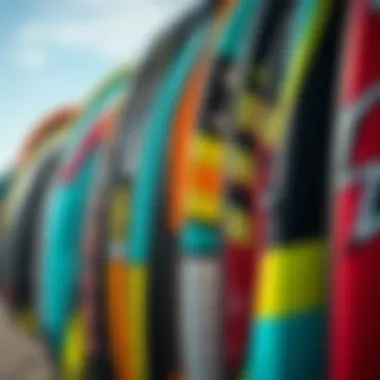
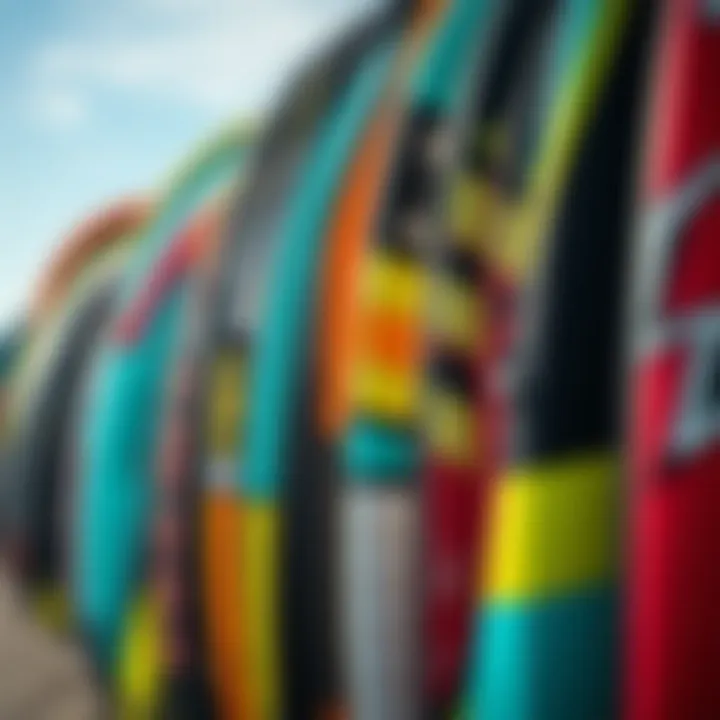
When it comes to kiteboarding kites, choosing the right retailer or brand can make all the difference. Not only does it influence your purchase experience, but it also directly impacts the quality of the product you’ll receive. Well-established retailers and reputable brands often ensure that you are getting gear that meets high standards of design and durability.
Top Kiteboarding Brands
A selection of the market's best kiteboarding kites can make your experience smoother than a calm sea. Some standout names are:
- North Kiteboarding: Known for their high-performance models, ideal for both freestylers and wave riders. Their attention to detail puts them at the forefront of kite innovation.
- Cabrinha: They offer a wide array of kites suitable for various riding styles, which cater to both novices and seasoned pros. Cabrinha’s commitment to performance and durability is well-recognized.
- Duotone: This brand is a favorite among competitive riders. Their kites provide excellent stability and control, allowing for advanced maneuvers.
- Slingshot: With a focus on versatility, Slingshot kites have a solid reputation for their durability and adaptability to different wind conditions.
"In kiteboarding, the gear can be the bridge between struggle and success. Knowing the brands that deliver quality is pivotal."
These brands not only offer high-quality products but also have a network of support, which can be invaluable for first-time buyers or those looking for advice on equipment.
Online vs. Local Purchase Options
Choosing between online retailers and local shops can indeed feel like navigating through a complex wind pattern. On the one hand, local shops provide the benefit of hands-on experience. You can hold the kite, feel its material, and seek advice in real-time from knowledgeable staff. Often, they might even have demo models available that you can test before buying. On the flip side, online shopping opens up a vast world of options and competitive pricing. Websites like Kiteboarding.com or BoardingHouse can offer pricing that might not be matched by local retailers due to fewer overhead costs.
Consider these points:
- Local Shops:
- Online Retailers:
- Pros: Personal interaction, immediate feedback, potential for demos, local community ties.
- Cons: Limited stock, usually higher prices.
- Pros: Wider selection, lower prices, often free shipping.
- Cons: Inability to physically check the product, potential delays in shipping.
Ultimately, the choice depends on your comfort level and need for immediate gratification versus the potential savings of an online purchase.
Customer Service Considerations
When diving into the waters of kiteboarding, understanding customer service policy can protect your investment. Strong customer support can assist with warranty issues, provide replacements if necessary, and offer guidance during your journey. For example:
- Are they accessible via live chat or phone?
- Do they have a reasonable return policy?
- Are their representatives knowledgeable about the sport and products?
Brands such as Duotone and Cabrinha have a reputation for responsive customer service, which can be reassuring for new buyers. Engaging with brands that have robust customer service can enhance the ownership experience, allowing you to focus more on riding than worrying about logistics.
When picking your kite, remember to take a good look not just at the kites but also at the brands and retailers selling them. They’ll play a significant role in your kiteboarding journey.
Kite Maintenance and Care
When it comes to kiteboarding, having the right gear is just half the battle. Just like a sailor must maintain their vessel, kiteboarders must also prioritize kite care to ensure performance and longevity. Regular maintenance helps avoid costly replacements and keeps the kite functioning optimally. Proper care allows kiteboarders to feel confident while zipping through the waves, knowing that their equipment is in top shape.
Cleaning Techniques
Kiteboarding kites can take a beating from the elements, yet a little washing can go a long way in extending the life of your gear. Here are several cleaning techniques that every kiteboarder should embrace:
- Rinse Off: After each use, especially in saltwater environments, rinse your kite with fresh water. Salt and sand can lead to wear and tear over time. Washing it down will help remove any particles and salt residue.
- Inspect Before Washing: Check your kite for any damage, like small tears or holes, before you start cleaning. Catching issues early can save you a heap of trouble down the line.
- Use Mild Detergent: If your kite is particularly dirty, consider using a mild soap designed for delicate materials. Avoid harsh chemicals that could degrade the fabric.
- Gentle Scrubbing: Use a soft sponge or cloth to gently scrub any stubborn stains. Avoid aggressive scrubbing, which might damage the surface.
- Air Dry: After cleaning, let your kite air dry completely before storing. This helps prevent mold and mildew from taking hold.
"A stitch in time saves nine." When caring for your kite, being proactive can prevent bigger issues later on.
Storage Recommendations
How and where you store your kite can significantly impact its lifespan. Here are some storage recommendations to keep your kite in pristine condition:
- Cool and Dry Place: Always store your kite in a cool, dry environment. Avoid leaving it in direct sunlight, as UV rays can weaken the fabric over time.
- Use a Bag: Most kites come with a storage bag. Utilize it to protect your gear from dust and potential damage. This adds an extra layer of care while keeping things organized.
- Avoid Tight Folding: When packing the kite away, avoid tight folds, as this can crease the fabric and weaken the material. Instead, consider loosely rolling it up.
- Check for Moisture: If you’ve been out riding in wet conditions, ensure the kite is thoroughly dried before packing it away. Storing a wet kite can lead to mildew, which ruins both performance and appearance.
- Store Inflation Bladders Separately: If you use bladders, storing them separately can prevent punctures and other damage.
In summary, proper maintenance of your kite is a game changer. Whether it’s through regular cleaning or the way you store it, each step is crucial for keeping your equipment in top form. With a well-maintained kite, you’re set for better performances and a longer lifespan of your gear.
For more information on kite care and maintenance, visit Kiteboarding.com or check out tips on Reddit for insights from fellow enthusiasts.
Advancements in Kite Technologies
The world of kiteboarding is ever-evolving, and the advancements in kite technologies play a significant role in reshaping the sport, making it safer, more accessible, and ultimately, more enjoyable. With innovation at the forefront, kites are not just pieces of canvas attached to lines; they are engineered marvels designed to perform under various conditions. Keeping up with these advancements is crucial for enthusiasts looking to elevate their riding experience.
Innovative Designs
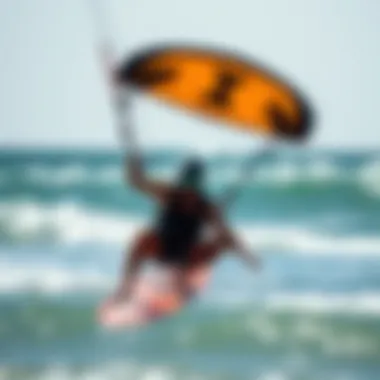
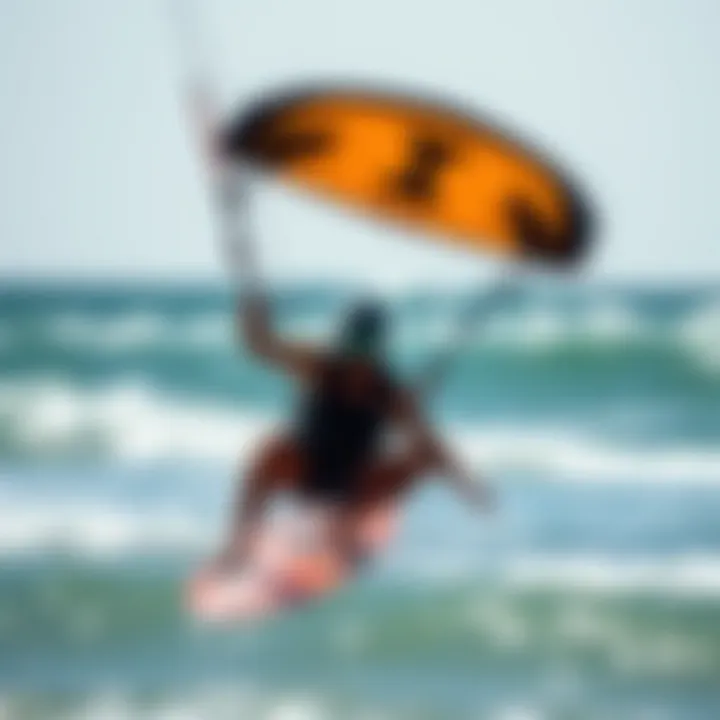
The kite design landscape has seen a whirlwind of creativity and functionality. Modern kites are crafted using advanced materials that not only enhance durability but also improve performance. For instance, designers now utilize ripstop nylon and spinnaker cloth, which are lighter yet stronger than traditional fabrics. These materials allow for larger canopy areas, resulting in better lift.
Designers have also begun focusing on aerodynamics more than ever before. The shape of the kite can greatly affect how it interacts with wind. The trend is moving towards flatter designs that optimize power without compromising responsiveness. Adopting a delta shape or even hybrid designs maximizes stability in varying wind conditions. For kiteboarders, this means more time cutting through waves and less time wrestling with wayward kites.
"Advancements in kite designs are not only about performance; they significantly impact safety and learning curves for new riders."
Safety, too, is a critical element in innovative designs. Features such as automatic depower systems allow a rider to provide a quick release in case of emergencies with just a flick of a wrist. This advancement has made it much easier for newcomers to get comfortable on the water without fear of losing control.
Smart Kites and Connectivity
As technology progresses, so does the integration of smart features into kiteboarding equipment. Smart kites are now capable of providing real-time feedback to the rider. Some high-end kites come equipped with sensors that track performance metrics such as altitude, speed, and wind direction. This can be instrumental in helping riders, from novices to experts, assess their skills and improve their techniques.
Moreover, connectivity allows for the use of apps that can predict weather patterns and optimize kite performance. Imagine being able to know exactly what size kite to use before arriving at the beach, based on real-time wind data. This is no longer a far-fetched dream; it’s a reality that’s shaping how enthusiasts prepare for their sessions.
With these technological advancements, the community of kiteboarders is expanding its horizons. Riders can connect with others worldwide, sharing tips and experiences or even participating in virtual competitions. The convergence of technology and kiteboarding is not just enhancing the sport—it’s redefining it.
Community and Resources
Kiteboarding is not just a sport; it’s a lifestyle fueled by passion and a sense of belonging. The community and resources available to kiteboarders play a crucial role in shaping the overall experience for both newcomers and seasoned enthusiasts. Engaging with a community can lead to friendships, shared learning, and increased safety, all while enhancing the fun factor of the sport. By connecting with others, kiteboarders can exchange tips, tricks, and resources, ensuring they are well-prepared for their next adventure on the water.
Kiteboarding Forums and Groups
Kiteboarding forums and groups serve as digital meeting places where enthusiasts gather to discuss everything from gear reviews to local conditions. These platforms are rife with personal anecdotes and advice, often providing insights that you won't find in guides or advertisements. For instance, Reddit’s kiteboarding community (reddit.com/r/kiteboarding) is a treasure trove of information where users share their experiences, ask questions, and offer recommendations. Participating in such forums can help new riders navigate the confusing world of kite options, as they often receive advice tailored to their individual needs.
Key benefits of participating in kiteboarding forums include:
- Expert Advice: Many seasoned riders frequent these spaces, offering their insights based on experience.
- Local Knowledge: Learn about the best kiteboarding spots in specific regions, especially beneficial if you’re planning to travel.
- Gear Swaps and Sales: Forums often have sections dedicated to trading or selling equipment, which can save you a hefty budget.
Besides forums, social media groups on platforms like Facebook provide a more visual approach to community engagement. Users often post their sessions, ask for help, or organize meet-ups, making it easier to connect on a personal level.
Events and Competitions
Participating in events and competitions can deepen engagement and elevate your skills. Local meet-ups or larger events foster camaraderie as kiteboarders of all levels come together to ride. These gatherings often feature contests, workshops, and demo days that can enhance learning. For instance, events like the Kiteboarding World Championships showcase the sport's highest level, inspiring participants and spectators alike.
Why Attend Events?
- Skill Development: Workshops are typically led by professionals who share valuable techniques.
- Networking: Meet fellow kiteboarders who share your passion, making it easier to arrange future rides together.
- Product Demos: Dive into the latest innovations in kite technology, often with opportunities to try before buying.
In addition, many competitions are not solely for professionals. Most host amateur categories, encouraging participation from gung-ho newcomers eager to test their mettle. Whether you win or lose, the experience can be exhilarating.
Attending local or international kiteboarding events is more than just a sporting experience; it’s about being part of a vibrant community united by a shared adventure. For those interested in upcoming competitions, websites like kiteforum.com and kitesurfing.com often maintain event calendars that detail dates and locations.
"In kiteboarding, it’s not just about the wind and the waves; it’s about the people who share this journey with you."
In summary, actively engaging in kiteboarding forums and participating in events not only enhances skills but also builds a strong network of support and friendship, allowing everyone to progress and enjoy the sport together.
Future Trends in Kiteboarding
The landscape of kiteboarding is continually evolving. Understanding future trends in kiteboarding is vital for both enthusiasts and industry players. Keeping an eye on what lies ahead helps in anticipating needs, shaping innovations, and staying competitive.
As kiteboarding gains immense popularity, several trends are emerging that will likely define the near future. This has implications not only for performance and sustainability but also shapes the overall experience for riders. The advancements in materials, designs, and technology are paving the way for a more refined and enjoyable ride.
Sustainability in Equipment Production
Sustainability is no longer just a buzzword—it’s a necessity. Current production methods oftentimes prioritize profit over the environment. However, the new wave of manufacturers is recognizing the significance of producing eco-friendly kiteboarding gear. The integration of sustainable practices can range from the materials used to the manufacturing processes themselves and is becoming increasingly important as consumers look for products that reflect their values.
Benefits of Sustainable Production
- Reduced Environmental Impact: The use of biodegradable or recyclable materials minimizes the ecological footprint.
- Consumer Trust: Brands championing sustainability can build stronger relationships with their customers, fostering loyalty.
- Regulatory Compliance: As government regulations tighten around manufacturing processes, sustainable practices can keep brands ahead of the curve.
Considerations for Purchasers
- When buying a kite, one might look for certifications or claims about the sustainability of materials.
- Understanding the brand's commitment to eco-friendly initiatives can aid customers in making informed choices.
Impact of Technology on the Sport
Technology is acting as a catalyst for progress in kiteboarding, leading not only to improved performance but also enhancing safety and enjoyment on the water. The next generation of kites is expected to feature innovations that will reshape how kiteboarding is experienced.
Examples of Technological Advancements
- Smart Kites: These kites might come equipped with sensors that provide real-time feedback on wind conditions and rider performance, significantly enhancing the user's experience.
- Enhanced Materials: New lightweight materials can lead to kites that are easier to handle and maneuver, thus appealing to both novices and experienced riders.
- Connectivity: Such innovations enable riders to connect with mobile apps that track their progress or share achievements with a wider community, further enriching engagement with the sport.









